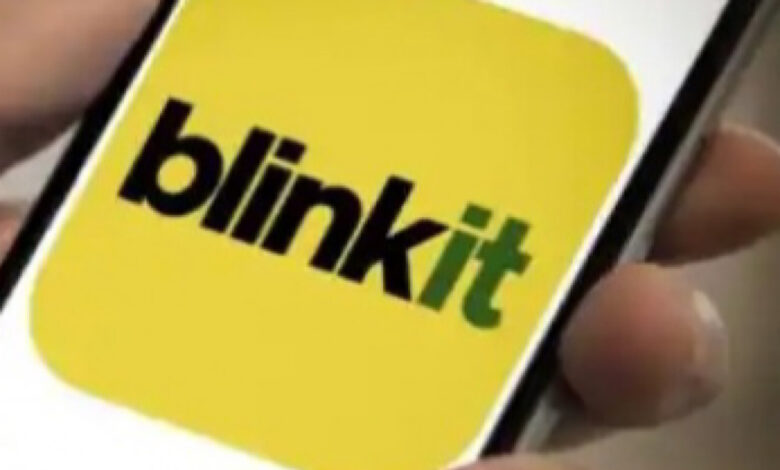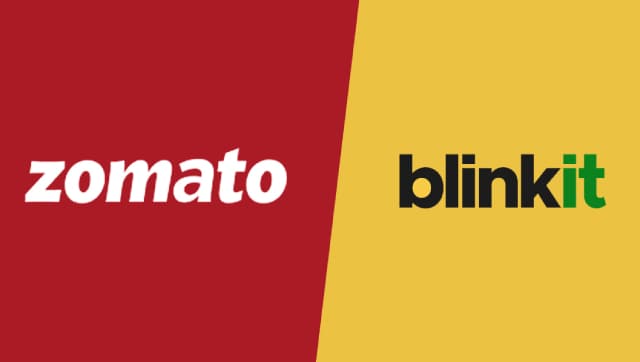Zomato’s Mega Plans For Blinkit, To Focus More On E-commerce Delivery; Q3 Growth Of Blinkit Shoots Past Zomato’s Amid Advertising Success
Zomato is all set to chart new territory with its rapid delivery arm, Blinkit. Blinkit has demonstrated promising strides, outpacing even Zomato's core food delivery business in recent quarters. Now, Zomato aims to strengthen Blinkit's presence in the ecommerce sphere by integrating various brands into its 10-minute delivery platform. The strategic move conveys Zomato's ambitious expansion into the direct-to-consumer (D2C) market. Meanwhile, Blinkit is seeing remarkable growth propelled by its advertising revenue- the growing number of advertisers on its platform, Blinkit is emerging as a promising avenue for brands looking to engage with a highly active consumer base.

Zomato’s strategy for Blinkit to expand its e-commerce operations comes after a period of extensive expenditure. However, the company’s quick commerce arm appears to have unlocked a formula for sustainable growth.
During the October-December (Q3) quarter of the 2023-24 fiscal year (FY24), its growth surpassed that of Zomato’s core food delivery business, fueled by a strong festive season and improved operational efficiencies.
It’s worth noting that while Blinkit’s revenue is only about a third of Zomato’s, its lower starting point also contributes to its accelerated growth.

Looking For More
Blinkit’s success has Zomato looking into new categories to integrate brands into its 10-minute delivery platform; however, it may encounter competition from established e-commerce giants like Amazon and Flipkart.
To achieve the ambitious expansion into the rapidly expanding direct-to-consumer (D2C) sector, Zomato will have to establish its own supply chain for sourcing branded products directly and managing inventory, all to be facilitated through Blinkit.
Zomato, currently ramping up its quick commerce goals, has engaged in discussions with individual brand owners across various sectors to stock their products; thus, the move is viewed by industry insiders as a potential driver for long-term growth.
The approach, however, does not entail Zomato taking direct ownership of inventory; instead, it involves managing product flows for D2C brands, similar to how marketplaces operate.
As part of this strategy, the company had earlier encountered at least two unsuccessful attempts to acquire and merge with Shiprocket, an e-commerce enablement firm known for its work with numerous D2C brands, which declined the proposed merger.
)
Stronger Supply Chain Management
Zomato acquired a stake in Shiprocket during the latter’s $185-million funding round in 2021, currently holding 6.6% of the logistics provider, as per Tracxn data.
While Shiprocket has not made any official statement on the matter
ongoing discussions between the two entities persist; as a result, Zomato has secured leases for warehouses in New Delhi and Mumbai to strengthen Blinkit’s e-commerce endeavours.
In addition to dominating the food delivery market, Zomato’s operations extend into various sectors such as business-to-business grocery supply through Hyperpure, and event ticketing with Zomaland, alongside a dining-out vertical.
Enhancing Ecommerce Capabilities
Analysts are eyeing Blinkit as Zomato’s next major growth avenue amid a slowdown in its core business growth.
Industry observers note the rising interest among modern direct-to-consumer (D2C) brands in utilizing quick commerce for sales, particularly in categories like home essentials, electronics, and personal care.
Thus, Zomato’s aim is to establish a backend infrastructure facilitating direct collaboration with brands for sales on Blinkit, thereby exerting greater control over its supply chain, is a good strategy.
India’s leading food delivery platforms, Zomato and Swiggy, are also diversifying their offerings. Swiggy for instance introduced its ecommerce marketplace, Minis, focusing on local delivery of various brands without marketplace fees.
Zomato, through Blinkit, plans to leverage hyperlocal warehouses and swift delivery timelines to compete with established players.
For Blinkit, expanding into new D2C categories aims to boost its average order value (AOV), a key metric contributing to revenue growth and minimizing losses.
Despite grocery businesses operating on thin margins, Blinkit’s strategy of diversification into higher-margin categories like electronics and personal care suggests improving profitability.

Competition And Strategy
While Flipkart has announced same-day deliveries for numerous products across 20 cities, ecommerce firms are increasingly narrowing delivery timelines to counter quick commerce firms’ competition.
Blinkit’s strategy involves capitalizing on events like cricket matches and festivals to promote D2C products, yielding higher-margin returns compared to groceries and FMCG goods.
Ads Propel Blinkit Beyond Zomato’s Food Delivery Growth in Q3
The growing opportunity in quick commerce advertising appears highly promising for Blinkit.
During the third quarter (Q3) of the fiscal year 2023-24 (FY24), the company witnessed a remarkable 220 percent year-on-year (YoY) growth in revenue from advertisements. The surge surpassed even Blinkit’s gross order value (GOV), which saw a robust 103 percent increase over the same period.
Likewise, the platform experienced a significant uptick in the number of advertisers, soaring by 130 percent to reach 557 in Q3, a substantial rise from 242 a year earlier. It’s worth noting, however, that this impressive growth in ad spends is relative to a modest starting point.
According to Blinkit’s senior management, the platform is swiftly becoming the preferred choice for advertising among both established and emerging brands in India.
Albinder Dhindsa, CEO of Blinkit, highlighted the transaction frequency on quick commerce platforms like Blinkit, emphasizing the platform’s highly engaged and rapidly expanding customer base with considerable spending power.
Nevertheless, Blinkit’s focus on brand-centric advertising is not entirely new; following the launch of its self-serve advertising platform for brands, Blinkit Brand Central, in December 2022, the company introduced a feature last year enabling brands to create custom pages and promote products within its app.
Through ‘Brand Stores,’ sellers gained access to real-time performance tracking of their products, enabling them to highlight items and customize their design as per relevance or customer preferences.
Dhindsa stressed the programmatic ad-bidding platform, offering brands flexibility in efficiently serving ads with various permutations and combinations; hence, this approach enables brands to optimize their ad spending effectively, targeting specific audience segments with precision.
Given the rapid order fulfilment in quick commerce, brands experience nearly real-time visibility into the impact of their advertising investments combined with the hyperlocal targeting capabilities offered by platforms like Blinkit, which translates to an enhanced return on investment for brands.
Over the past five quarters, this trend has spurred a noteworthy uptick in both the number of advertisers and the average ad spend per advertiser on the Blinkit platform.

Growth
The substantial increase in advertising revenue stands out as one of the primary drivers behind Blinkit’s rapid expansion in the third quarter (Q3), which demonstrated continued profitability for the second consecutive quarter.
The platform witnessed an impressive 113 percent year-on-year (YoY) surge in overall revenue, soaring from Rs 301 crore in the year-ago period to Rs 644 crore in Q3.
Blinkit’s staggering growth trajectory in Q3 is accentuated by its gross order value (GOV) surge of 103 percent YoY, significantly outpacing the growth of Zomato’s food delivery business, which registered a 27 percent increase during the same period.
The vigorous performance of Blinkit’s GOV, reaching Rs 3,542 crore in Q3 compared to Rs 1,749 crore a year ago and Rs 2,760 crore in the previous quarter, largely stemmed from heightened volumes during the festive season.
Furthermore, the platform witnessed a notable uptick in the total number of orders, soaring to 55.8 million in Q3 from 45.5 million in the previous quarter, while monthly transacting users experienced a quarter-on-quarter (QoQ) rise from 4.7 million to 5.4 million.
Enhanced sales across categories such as electronics, festive essentials, and home decor contributed to higher average order values (AOVs), with Blinkit’s AOV reaching Rs 635 for the quarter, up from Rs 607 in Q2.
Sustainable Expansion
Despite the quarterly increase in Blinkit’s dark store count from 411 to 451 in Q3, the platform observed a notable 17 percent QoQ growth in average GOV per day, per store.
Albinder Dhindsa noted that in Q3FY24, approximately 70 percent of their stores were contribution positive, with around 20 percent operating at over a 5 percent contribution margin, indicating a growing pool of contribution profit.
Similarly, the company’s new dark stores are achieving a volume of 1,000 orders per day, a threshold typically associated with contribution break-even, within nearly two months, significantly faster than the 5.8-month average in Q4 FY23.
This accelerated pace has reduced the investment per store, facilitating further expansion without impacting the company’s adjusted EBITDA break-even timeline.
The bulk of Blinkit’s network expansion remains concentrated in its top eight cities, which collectively contribute around 90 percent of the firm’s GOV.




